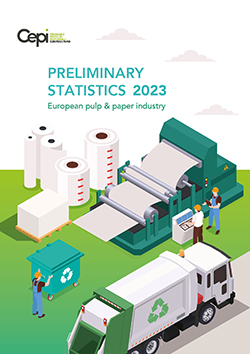 Suffering from an adverse macro-economic context, production of pulp and paper in Europe has experienced a decline in 2023. It was due to several compounding external factors: a poor economic environment, de-stocking and high energy costs, as shown by the Cepi preliminary statistics report published recently.
Suffering from an adverse macro-economic context, production of pulp and paper in Europe has experienced a decline in 2023. It was due to several compounding external factors: a poor economic environment, de-stocking and high energy costs, as shown by the Cepi preliminary statistics report published recently.
With mid-term global economic trends impacting the demand for paper and board and exacerbating de-stocking, consumption fell by 15.3% in 2023 and, in turn, production in the paper and board industry suffered a second consecutive year of contraction, decreasing by 12.8%. After 2022 was marked by sky high energy prices, the decrease in production in 2023 continues to be more pronounced, even than it was during the COVID-19 crisis (-4.7% in 2020).
These global trends have been worsened by the comparative high costs in Europe for production inputs, and notably energy, which cost continues to be unsustainably high. This is illustrated by Europe’s domestic paper and board production contracting more than in many other world regions, where decreases ranged between -2% and -10%. But, in a globalised low demand context, both imports and exports diminished equally, and Europe’s pulp and paper’s trade balance remains by far positive, as it is one of the top EU manufacturing sectors by this measure.
Traditionally an engine for growth in the sector, the production of packaging paper and board in Europe has also continued on a downward trend, with consumption decreasing by 12.2%. The segment has suffered from a slowdown in retail and e-commerce figures having reverted back from pandemic levels. This in turn impacted the consumption of paper for recycling (-7.3%), as paper-based packaging in Europe is predominantly made of recycled material.
Graphic paper, which includes printing and writing paper, saw consumption drastically decrease (-27.5%). This can only partly be explained by longstanding trends towards more digital content, as de-stocking effects could possibly account for up to half of the decline. Within this category the book sub-segment remained resilient.
Sanitary and household paper also appeared much more stable than other segments, with a limited decline of -3.7%. These are still benefiting from societal trends favourable towards hygiene products, with ‘at home’ markets including tissues and toilet paper performing better than ‘away-from-home’ markets, more impacted by inflation and sluggish private consumption.
Jori Ringman, Director General, Cepi, said, “Out of all the macro-economic issues born of the crises of the recent years, improving basic operating and investment conditions for the EU’s manufacturing sector, while still being a big challenge, might still be one of the lowest hanging fruits for EU policymakers.”
The full report can be downloaded here.



